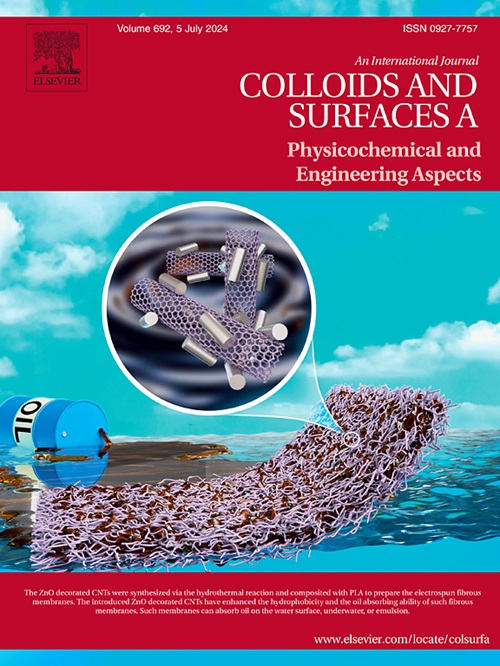用于污泥脱水的调节剂对污泥衍生吸附剂吸附性能的影响
IF 4.9
2区 化学
Q2 CHEMISTRY, PHYSICAL
Colloids and Surfaces A: Physicochemical and Engineering Aspects
Pub Date : 2024-10-09
DOI:10.1016/j.colsurfa.2024.135526
引用次数: 0
摘要
将废弃活性污泥转化为吸附剂是一种很有前景的污泥资源化方法。虽然在污泥调理和脱水过程中广泛使用了各种调理剂,但这些调理剂对污泥衍生吸附剂特性的影响在很大程度上仍未得到研究。本研究使用了四种调节剂(包括 FeCl3、CaO、聚丙烯酰胺、FeSO4-7H2O/Na2S2O8)对污泥进行调节,并对污泥脱水性和所得吸附剂的吸附性能进行了评估。从高到低依次为聚丙烯酰胺、FeCl3、FeSO4-7H2O/Na2S2O8 和 CaO。调节剂的类型对污泥吸附剂的吸附能力影响很大:FeSO4-7H2O/Na2S2O8增强了吸附能力,而其他调节剂则降低了吸附能力。吸附剂的红外光谱、孔径分布和微观形态分析表明:FeCl3 通过强烈的静电作用减少了中孔;CaO 成为吸附的物理屏障;聚丙烯酰胺通过氢键驱动的架桥作用减少了吸附剂的表面积,并可能形成聚合物屏障;FeSO4-7H2O/Na2S2O8 破坏了污泥絮体,暴露出丰富的吸附位点,显著提高了吸附剂的性能。因此,FeSO4-7H2O/Na2S2O8 调节对污泥脱水和吸附都有好处。经 FeSO4-7H2O/Na2S2O8 调理的污泥吸附剂对亚甲基蓝的吸附用假秒阶模型和 Langmuir 模型进行了最佳描述,表明单层化学吸附占主导地位。吸附主要发生在吸附剂的中孔,羟基和羧基中的羰基是主要的结合位点。薄膜和孔隙扩散都对吸附速率有影响,其中孔隙扩散是限制吸附速率的主要步骤。结果凸显了破坏性调节方法对污泥吸附剂性能的有利影响。本文章由计算机程序翻译,如有差异,请以英文原文为准。
Effect of conditioners used for sludge dewatering on the adsorption performance of sludge-derived adsorbent
Converting waste activated sludge into adsorbent is a promising alternative for sludge valorization. While various conditioners are widely employed in sludge conditioning and dewatering processes, the influence of these conditioners on the properties of sludge derived adsorbents remains largely unexplored. Four conditioners, including FeCl3, CaO, polyacrylamide, FeSO4·7H2O/Na2S2O8, were used for sludge conditioning, and the sludge dewaterability and the adsorption performance of the resultant adsorbents were evaluated. The sludge dewaterability was markedly improved by the conditioners in a descending order as polyacrylamide, FeCl3, FeSO4·7H2O/Na2S2O8, and CaO. The type of conditioner highly influenced the adsorption ability of the sludge adsorbent: FeSO4·7H2O/Na2S2O8 enhanced the adsorption ability, while others deteriorated it. Infrared spectra, pore size distribution, and micromorphology analysis of the adsorbents suggest that: FeCl3 reduced mesopores through strong electrostatic interactions; CaO acted as a physical barrier for adsorption; polyacrylamide reduced the adsorbent surface area through hydrogen bond-driven bridging and potentially forming polymeric barrier; FeSO4·7H2O/Na2S2O8 disrupted the sludge flocs and exposed abundant adsorption sites, promoting the adsorbent performance markedly. FeSO4·7H2O/Na2S2O8 conditioning was thus beneficial to both sludge dewatering and adsorption. Adsorption of methylene blue by FeSO4·7H2O/Na2S2O8-conditioned sludge adsorbent was best described by the pseudo-second-order model and Langmuir model, indicating the dominance of monolayer chemisorption. The adsorption mainly occurred in the mesopores of the adsorbent, with hydroxyl group and carbonyl in carboxyl group as the main binding sites. Both film and pore diffusion contributed to the adsorption rate, with pore diffusion serving as the main rate limiting step. Results highlight the beneficial effect of destructive conditioning method on sludge adsorbent performance.
求助全文
通过发布文献求助,成功后即可免费获取论文全文。
去求助
来源期刊
CiteScore
8.70
自引率
9.60%
发文量
2421
审稿时长
56 days
期刊介绍:
Colloids and Surfaces A: Physicochemical and Engineering Aspects is an international journal devoted to the science underlying applications of colloids and interfacial phenomena.
The journal aims at publishing high quality research papers featuring new materials or new insights into the role of colloid and interface science in (for example) food, energy, minerals processing, pharmaceuticals or the environment.

 求助内容:
求助内容: 应助结果提醒方式:
应助结果提醒方式:


